
The Panama–California Exposition was an exposition held in San Diego, California, between January 1, 1915, and January 1, 1917. The exposition celebrated the opening of the Panama Canal, and was meant to tout San Diego as the first United States port of call for ships traveling north after passing westward through the canal. The fair was held in San Diego's large urban Balboa Park.

Hillcrest is a neighborhood in San Diego, California lying northwest of Balboa Park and south of Mission Valley.
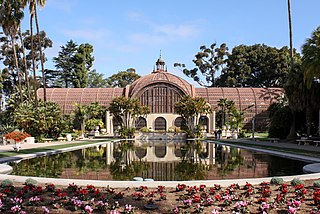
Balboa Park Gardens are cultivated areas of Balboa Park in San Diego, California.
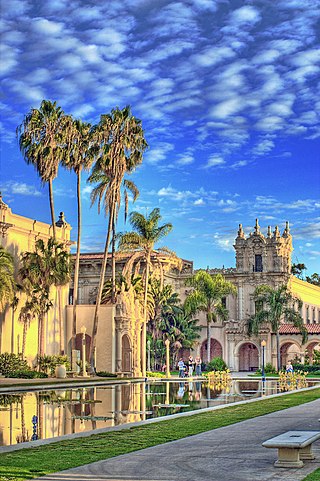
The California Pacific International Exposition was an exposition held in San Diego, California during May 29, 1935–November 11, 1935 and February 12, 1936–September 9, 1936. The exposition was held in Balboa Park, San Diego's large central urban park, which had also been the site of the earlier Panama-California Exposition in 1915.

Katherine Olivia "Kate" Sessions was an American botanist, horticulturalist, and landscape architect closely associated with San Diego, California, and known as the "Mother of Balboa Park."
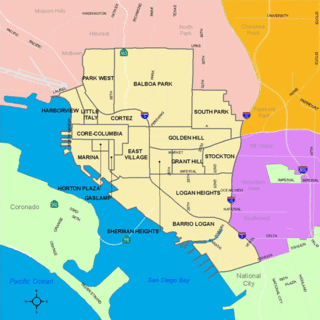
Golden Hill is a neighborhood of San Diego, California. It is located south of Balboa Park, north of Sherman Heights/Highway 94, and east of Downtown.

Spreckels Organ Pavilion houses the open-air Spreckels Organ in Balboa Park, San Diego, California. The Spreckels Organ is the world's largest pipe organ in a fully outdoor venue. Constructed for the 1915 Panama-California Exposition, it is located at the corner of President's Way and Pan American Road East in the park.

The Starlight Bowl is an amphitheater located in Balboa Park in San Diego, California. It was constructed for the 1935–1936 California Pacific International Exposition and seats 4,300. It was originally named the Ford Bowl because the automobile manufacturer sponsored outdoor concerts at the venue during the exposition by the Mormon Tabernacle Choir, the San Francisco Symphony, and other performers.
The Eastbay-Foot Locker Cross Country Championships are a series of annual cross country running races held in various regions of the United States to determine the premier cross country runner in various age groups, but mainly serves to find the best prep cross country athlete in the country. The event began in 1979 by the F. W. Woolworth Company, which initially branded it as the Kinney Cross Country Championships, at the Morley Field Sports Complex in Balboa Park, San Diego, California before Woolworth rebranded the event in 1993 to the Foot Locker Cross Country Championships for Woolworth's sporting goods company. For most people associated with the sport, the name was just shortened to Foot Locker or even abbreviated in agate results as FL. In 2021 the event was rebranded again as the Eastbay Cross Country Championships after the Foot Locker owned company. The event is the longest-running national cross country race for high school students.

Naval Medical Center San Diego (NMCSD), also known as Bob Wilson Naval Hospital and informally referred to as "Balboa Hospital", or "The Pink Palace" (because the stucco of the first buildings that were constructed was pinkish in color), is a technologically advanced Navy medical treatment facility. Located within the grounds of Balboa Park in San Diego, the hospital has played a role in the history of San Diego for more than 100 years. The goal has remained constant, to provide the finest medical care in a family-centered care environment to operational forces, their families, and veterans. Organizationally, the hospital is first and foremost a military command.

The San Diego Art Institute was a contemporary art museum focusing on artists from the Southern California and Baja Norte region. It was founded in 1941 as the San Diego Business Men's Art Club. Its name was changed in 1950 to the San Diego Art Institute. In 1953, women were admitted for membership. It officially became a nonprofit in 1963. The San Diego Art Institute in Balboa Park and Lux Art Institute in Encinitas merged in September 2021 to become The Institute of Contemporary Art, San Diego, with each museum continuing to operate at its respective site.

The thong is a garment generally used as either underwear or in some countries, as a swimsuit. It may also be worn for traditional ceremonies or competitions.
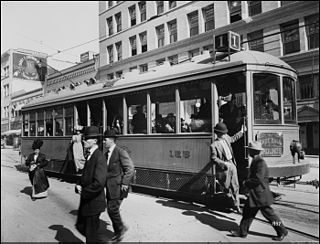
The San Diego Class 1 streetcar was a fleet of twenty-four unique streetcars that were originally built to provide transportation for the Panama-California Exposition in Balboa Park. The cars were designed by the San Diego Electric Railway Company (SDERy) under the leadership of John D. Spreckels and built by the St. Louis Car Company (SLCCo). These cars, which took the best elements from preceding models and integrated them into a new, modern streetcar design, went on to serve the many neighborhoods of San Diego until they were retired in 1939.

Balboa Park is a 1,200-acre (490 ha) historic urban cultural park in San Diego, California, United States. In addition to open space areas, natural vegetation zones, green belts, gardens, and walking paths, it contains museums, several theaters, and the San Diego Zoo. There are also many recreational facilities and several gift shops and restaurants within the boundaries of the park. Placed in reserve in 1835, the park's site is one of the oldest in the United States dedicated to public recreational use. Balboa Park is managed and maintained by the Parks and Recreation Department of the City of San Diego.

The Japanese Friendship Garden, also known as Sankei-en is a twelve-acre Japanese garden located within Balboa Park in San Diego, California. It is an expression of friendship between San Diego and its Japanese sister city Yokohama that binds the two cultures to create a unique experience for visitors from all over the world; over 240,000 people from across the United States and the world visit the garden annually. Representing a new concept in the development of a Japanese garden outside Japan, the Japanese Friendship Garden is designed to present an atmosphere of elegant simplicity (shibui) and quiet beauty. The garden's naturalistic design is guided by the original principles/techniques of the Japanese garden while incorporating elements of the regional San Diego landscape and climate; in terms of features, the garden is well known for its unique placement, sukiya-style buildings, koi ponds, and landscape exhibits. The Japanese Friendship Garden also hosts many local educational programs, activities, festivals, and horticultural classes that focus on the relationship between nature and Japanese culture.

Zoro Garden is a 6-acre sunken garden within Balboa Park in San Diego, California. It is located between the Reuben H. Fleet Science Center and the Casa de Balboa. The name refers to the Persian mystic Zoroaster.
A French postcard is a small, postcard-sized piece of cardstock featuring a photograph of a nude or semi-nude woman. Such erotic cards were produced in great volume, primarily in France, in the late 19th and early 20th century. The term was adopted in the United States, where such cards were not legally made. The cards were sold as postcards, but the primary purpose was not for sending by mail, as they would have been banned from delivery. The cards sometimes even depicted naked lesbians. French street vendors, tobacco shops and a variety of other vendors bought the photographs for resale to tourists.
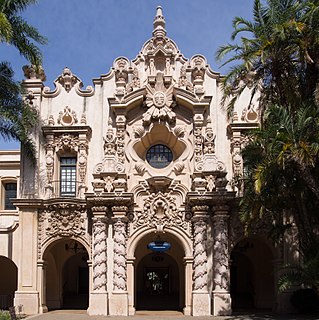
The Casa del Prado comprises several reconstructed buildings that were initially built for the Panama–California Exposition in San Diego's Balboa Park, in the U.S. state of California. Current tenants include the San Diego Botanical Garden Foundation, Civic Dance Arts, the San Diego Floral Association, the San Diego Civic Youth Ballet, the San Diego Junior Theatre, and the San Diego Youth Symphony.
Morley Field Sports Complex is a sports complex in Balboa Park in San Diego, California. The sports complex was named after John Morley, who served as a park superintendent in Balboa Park from 1911 to 1939.
















